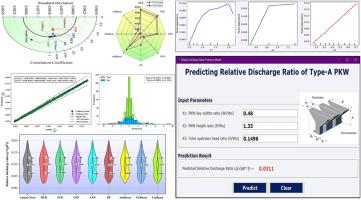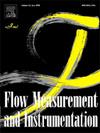Enhancing discharge prediction over Type-A piano key weirs: An innovative machine learning approach
IF 2.3
3区 工程技术
Q2 ENGINEERING, MECHANICAL
引用次数: 0
Abstract
Piano key weirs (PKWs) are an increasingly popular hydraulic structure due to their higher discharge capacity than linear weirs. Accurately predicting the discharge of PKWs is essential for appropriate design and operation. This study utilized eight Machine Learning algorithms, including non-ensemble and ensemble models to predict the discharge of type-A PKWs. Multiple-Linear-Regression (MLR), Support-Vector-Machine (SVM), Gene-Expression-Programming (GEP), and Artificial-Neural-Network (ANN) were adopted as non-ensemble models. While the ensemble models comprised Random-Forest (RF), Adaptive-Boosting (AdaBoost), Extreme-Gradient-Boosting (XGBoost), and Categorical-Boosting (CatBoost). A total of 476 experimental datasets were collected from previous research considering three critical dimensionless input parameters: PKW key widths, PKW height, and total upstream head. The models were trained on 70 % of the dataset and tested on the remaining 30 %. The hyperparameters of the models were optimized using the Bayesian Optimization technique, with 5-fold cross-validation ensuring high performance. Comprehensive analyses, including visual and quantitative methods, were employed to validate model effectiveness. CatBoost model consistently outperformed the other models, achieving the highest Determination-coefficient (R2 = 0.998) and lowest Root-Mean-Squared-Error (RMSE = 0.002), highlighting its ability to handle complex data patterns and its superior optimization process. XGBoost follows closely behind, showing strong generalization, while ANN and RF perform well, but it's a slight increase in error metrics. The study also incorporated Shapley-Additive-exPlanations (SHAP) and Partial-Dependence-Plot (PDP) analyses, revealing that the total upstream head variable had the most significant impact on the discharge predictions. An interactive Graphical-User-Interface was developed to facilitate practical applications, enabling engineers to predict discharge quickly and economically.

加强 A 型钢琴键围堰的泄流预测:创新的机器学习方法
琴键堰(PKW)因其比直线堰更大的泄洪能力而成为一种越来越受欢迎的水利结构。准确预测 PKW 的泄洪量对于适当的设计和运行至关重要。本研究采用了八种机器学习算法(包括非集合模型和集合模型)来预测 A 型 PKW 的泄洪量。非集合模型采用了多元线性回归(MLR)、支持向量机(SVM)、基因表达编程(GEP)和人工神经网络(ANN)。而集合模型包括随机森林(RF)、自适应提升(AdaBoost)、极度梯度提升(XGBoost)和分类提升(CatBoost)。考虑到三个关键的无量纲输入参数,从以前的研究中总共收集了 476 个实验数据集:PKW 键宽、PKW 高度和上游总水头。模型在 70% 的数据集上进行了训练,并在其余 30% 的数据集上进行了测试。使用贝叶斯优化技术对模型的超参数进行了优化,并进行了 5 次交叉验证,确保了模型的高性能。为了验证模型的有效性,我们采用了包括视觉和定量方法在内的综合分析。CatBoost 模型的性能始终优于其他模型,获得了最高的确定系数(R2 = 0.998)和最低的均方根误差(RMSE = 0.002),突出了其处理复杂数据模式的能力和卓越的优化过程。XGBoost 紧随其后,显示出很强的泛化能力,而 ANN 和 RF 表现不俗,但误差指标略有增加。研究还纳入了 Shapley-Additive-exPlanations (SHAP) 和 Partial-Dependence-Plot (PDP) 分析,发现上游总水头变量对排水量预测的影响最大。为方便实际应用,还开发了交互式图形用户界面,使工程师能够快速、经济地预测排水量。
本文章由计算机程序翻译,如有差异,请以英文原文为准。
求助全文
约1分钟内获得全文
求助全文
来源期刊

Flow Measurement and Instrumentation
工程技术-工程:机械
CiteScore
4.30
自引率
13.60%
发文量
123
审稿时长
6 months
期刊介绍:
Flow Measurement and Instrumentation is dedicated to disseminating the latest research results on all aspects of flow measurement, in both closed conduits and open channels. The design of flow measurement systems involves a wide variety of multidisciplinary activities including modelling the flow sensor, the fluid flow and the sensor/fluid interactions through the use of computation techniques; the development of advanced transducer systems and their associated signal processing and the laboratory and field assessment of the overall system under ideal and disturbed conditions.
FMI is the essential forum for critical information exchange, and contributions are particularly encouraged in the following areas of interest:
Modelling: the application of mathematical and computational modelling to the interaction of fluid dynamics with flowmeters, including flowmeter behaviour, improved flowmeter design and installation problems. Application of CAD/CAE techniques to flowmeter modelling are eligible.
Design and development: the detailed design of the flowmeter head and/or signal processing aspects of novel flowmeters. Emphasis is given to papers identifying new sensor configurations, multisensor flow measurement systems, non-intrusive flow metering techniques and the application of microelectronic techniques in smart or intelligent systems.
Calibration techniques: including descriptions of new or existing calibration facilities and techniques, calibration data from different flowmeter types, and calibration intercomparison data from different laboratories.
Installation effect data: dealing with the effects of non-ideal flow conditions on flowmeters. Papers combining a theoretical understanding of flowmeter behaviour with experimental work are particularly welcome.
 求助内容:
求助内容: 应助结果提醒方式:
应助结果提醒方式:


